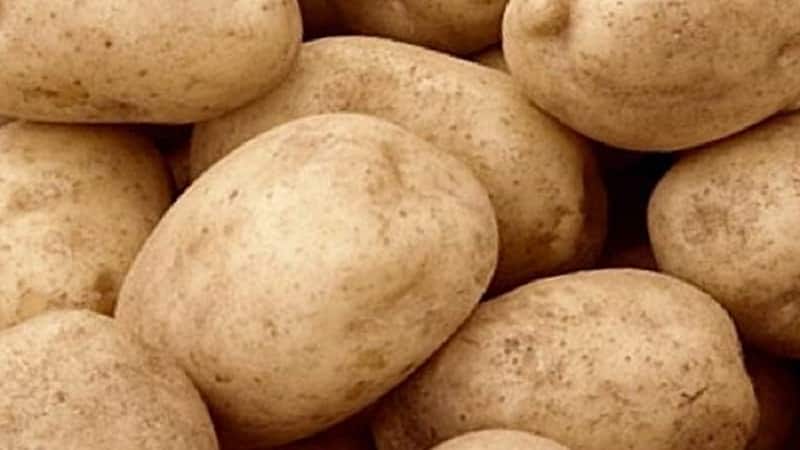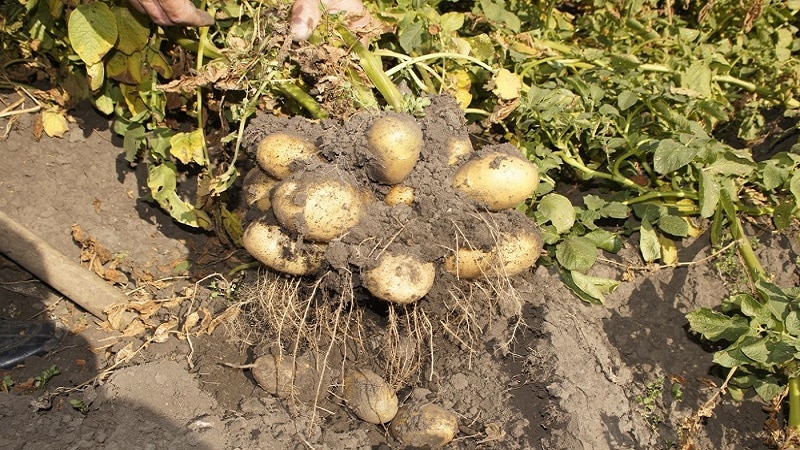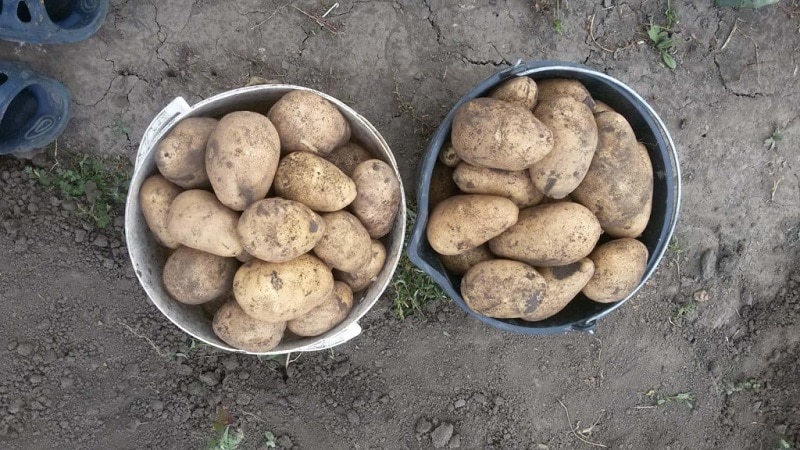The mid-late potato variety Tuleevsky, popular among gardeners
Tuleyevsky potato is an unpretentious variety with strong immunity to diseases and resistance to adverse weather conditions. With proper care, it produces high yields even on poor soils. The starchy, tasty tubers are versatile in cooking and suitable for long-term storage. What are its features, you will find out further.
What kind of potato is this?
The Tuleevsky variety was bred by domestic breeders specifically for cultivation in harsh Siberian conditions. Named in honor of the former head of the Kemerovo region A. Tuleyev, that’s why it is sometimes called the governor’s.

Origin and development
The variety was obtained as a result of crossing breeding samples Chernsky and Tolokan while maintaining the best taste characteristics. Potatoes were included in the State Register of the Russian Federation in 2006.
Since then, it has gained a well-deserved reputation as an unpretentious crop, suitable for cultivation on an industrial scale and in private gardens.
Peculiarities
Tuleevsky - universal table variety with good yield. Main features of the variety:
- genetically inherent immunity to late blight, potato canker, scab, Alternaria;
- marketability of mature tubers - 88–99%;
- keeping quality - 90%;
- good adaptation to changes in weather conditions, drought resistance;
- minimizing mechanical damage during harvesting due to the compactness of the bushes.
Other potato varieties:
Productive and disease-resistant variety “Ivan da Marya”
Characteristics of the variety
Under favorable weather conditions Tuleevsky produces fruits 90–110 days after planting. Gardeners dig up the first tubers “for testing” already on the 55th–65th day of the growing season.
Potato bushes are compact, of medium height. The length of the erect stems reaches 30–40 cm. The color of the leaves is predominantly dark, the leaf blade is even, with slight wavy edges. Flowering is of low intensity, the corollas are large, white or yellowish. Berries are produced rarely and in small quantities.
Sami tubers are oblong-oval with small eyes, smooth. The peel and pulp are yellow. The weight of one potato is 122–270 g. The taste is excellent. Starch content - 13.7–16.8%.
Marketable yield — 180–424 c/ha (4–6 kg per bush). The maximum figure of 458 c/ha was obtained in the Omsk region.

How to grow
Unpretentiousness is the main advantage of Tuleyevsky potatoes. Bad weather conditions, soil quality and a meager amount of moisture during the growing season do not prevent the emergence of friendly shoots on the site. But it is important to observe certain conditions when growing crops.
On a note. Experienced summer residents have noticed that it is better to plant potatoes during the period of mass flowering of dandelions. This happens when the earth has warmed up enough.
Dates, scheme and rules of planting
When growing governor's potatoes, special attention is paid to pre-planting preparation. She includes several stages:
- Greening tubers. The seed material is removed from the cellar and laid out on the ground during the day to green the peel. This is done at an air temperature of +13...+15°C in the shade for 7–10 days.
- Prevention of nematode damage. Prepared tubers are sprayed with “Prestige” or “Tabu” solution twice with an interval of 5 days.
- Soaking in Epin solution to stimulate the growth of “dormant” eyes.

The soil for potatoes is prepared in the fall in the standard way: the bed is dug up to a depth of 30 cm, weeds are removed. The crop is planted according to a pattern of 50–60 cm between rows and 50–60 cm between holes. This “marking” is well suited for compact bushes of mid-season potatoes. Depending on the quality of the soil, the tubers are buried 15–20 cm.
On a note. Like any crop of the Solanaceae family, potatoes do not like acidic soil. Soils with high acidity are limed with dolomite flour, crushed chalk, and eggshells.
Care
Low bushes of the Tuleevsky variety grow well in shaded areas and do not require constant attention. The culture can easily tolerate long dry periods, but requires hilling.
Up to three hillings are carried out per season with simultaneous removal of weeds:
- 5–7 days from emergence.
- During the period of mass flowering with simultaneous application of fertilizing.
- At the first signs of wilting of the tops, after heavy watering or rain.
As additional nutrition, apply under the bushes a solution of fresh cow manure, chicken or rabbit droppings in a ratio of 1:8.
Attention! Tuleyevsky potatoes do not tolerate adding large amounts of mineral fertilizers to the soil. Preference is given to humus or homemade compost.
Water the vegetable only in dry, hot weather.which lasts about a month.

Possible difficulties, diseases and pests
Lack of boron in the soil can cause serious harm governor's variety.During the period of flower formation, the ovaries on “starving” plants quickly fall off, which leads to loss of yield. Signs of boron starvation are poor pigmentation of the leaves, thickening and shortening of the tops, drying out of their tops.
For prophylaxis 30–35 days after planting seedlings are sprayed with a solution of boric acid (at the rate of 2 g per 10 liters of warm spring water). Do this early in the morning or late in the evening.
The variety is prone to damage by the golden potato nematode. To prevent rapid reproduction of worms in the area, tubers are planted after cucumbers, radishes, cabbage, beans, and peas.
Read also:
Collection, storage and use of crops
Harvesting tubers is simple and quick due to the structural features of the bush. Seed material for planting next year is selected from the garden bed, washed, and dried in the open air. Store in a cellar in a separate box at a temperature of +5...+6°C. The remaining vegetables are sorted, rotten ones, those affected by pests and those with mechanical damage are rejected. Potatoes are stored in a dry, dark place until spring.
The variety's tubers are medium starchy, excellent for boiling, frying, and stewing. During heat treatment, they remain intact, do not disintegrate, the pulp acquires a more intense shade and a characteristic potato aroma.

Advantages and disadvantages
Tuleevsky produces excellent yields in harsh Siberian conditions. If there is a hot, humid summer, it is possible to harvest 2 crops per season. The tubers do not rot and retain their presentation and taste until spring.
Disadvantages of Potatoes:
- intolerance to proximity to other varieties when planting and storing crops;
- susceptibility to golden nematode;
- the need for regular hilling to form tubers.
What regions is it suitable for?
Tuleyevsky is cultivated in West Siberian, Volga-Vyatka, East Siberian and Far Eastern regions of Russia. Due to its good endurance in difficult climatic conditions, the variety is successfully used by large farmers and small private enterprises.
Farmer reviews
Experienced and beginners vegetable growers have different attitudes towards the variety.
Ivan, Chelyabinsk: “I planted potatoes for sale for the first time, I took the risk of choosing Tuleyevsky. It was a little troublesome with hilling: labor costs at this stage are the highest. But I liked cleaning it: it was quick and convenient, the bushes were compact. From some I collected 6.5 kg, tubers - up to 350 g.".

Maria, Biysk: “On a personal plot of 12 acres, I plant 3 acres of potatoes annually. Before that, I had been planting Adretta for about seven years and considered it the best in taste. Last year I completely changed the tubers to new ones, the Tuleevsky variety. I don't regret it. The bushes are neat, no disease has taken them. The vegetables were aromatic and lasted until spring without spoiling. I personally recommend sorting in the winter: I noticed that the crop does not like excess moisture in the boxes.”.
Alexey, Orel: “I grow Tuleyevsky on the recommendation of a familiar breeder. Advantages: potatoes have excellent taste, the bushes are small and require minimal care. Among the shortcomings, I note that at my own dacha I have never received more than 5 kg from a bush.”.
Conclusion
Unpretentiousness to soil composition, climatic conditions and persistent immunity to diseases makes Tuleyevsky potatoes universal for cultivation throughout Russia. Compact bushes give equally good harvests when grown on an industrial scale and when planted on “6 acres”.